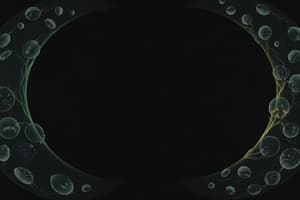Podcast
Questions and Answers
What characterizes the G0 phase of the cell cycle?
What characterizes the G0 phase of the cell cycle?
- Cells continue to metabolize but cannot divide. (correct)
- Cells are preparing for mitosis.
- Cells are completely inactive.
- Cells divide rapidly.
Which of the following cells are examples of terminally differentiated cells that remain in G0?
Which of the following cells are examples of terminally differentiated cells that remain in G0?
- Eye cells (correct)
- Stem cells
- Lung cells
- Liver cells
Which type of cell is known to be able to be called out of the G0 phase?
Which type of cell is known to be able to be called out of the G0 phase?
- Mature cardiac cells
- Stem cells (correct)
- Mature blood cells
- Mature nerve cells
Recent research indicates that brain cells can continually turn over in which area of the brain?
Recent research indicates that brain cells can continually turn over in which area of the brain?
What is the primary function of the hippocampus in relation to cell turnover?
What is the primary function of the hippocampus in relation to cell turnover?
What occurs during the G2 phase of the cell cycle?
What occurs during the G2 phase of the cell cycle?
What happens to the chromosomes during the G2 phase?
What happens to the chromosomes during the G2 phase?
Why does the transport demand increase as the cell grows during G2?
Why does the transport demand increase as the cell grows during G2?
What indicates the readiness of a cell to enter the M phase?
What indicates the readiness of a cell to enter the M phase?
Which of the following is a significant activity that occurs during the G2 phase?
Which of the following is a significant activity that occurs during the G2 phase?
What is the primary role of the hippocampus?
What is the primary role of the hippocampus?
What happens to one of the daughter cells after mitosis and cytokinesis in G₀ phase?
What happens to one of the daughter cells after mitosis and cytokinesis in G₀ phase?
During which phase does DNA replication occur?
During which phase does DNA replication occur?
What structural feature connects sister chromatids?
What structural feature connects sister chromatids?
What type of cells can hematopoietic stem cells produce?
What type of cells can hematopoietic stem cells produce?
What is the primary function of mitosis in the cell cycle?
What is the primary function of mitosis in the cell cycle?
Which stage directly follows prophase in mitosis?
Which stage directly follows prophase in mitosis?
During which phase do the chromosomes align at the cell's equatorial plane?
During which phase do the chromosomes align at the cell's equatorial plane?
What is the purpose of cytokinesis in the cell cycle?
What is the purpose of cytokinesis in the cell cycle?
How many distinct stages are typically identified in mitosis?
How many distinct stages are typically identified in mitosis?
What is the longest phase of mitosis?
What is the longest phase of mitosis?
Which structure forms during prophase to assist in chromosome movement?
Which structure forms during prophase to assist in chromosome movement?
What happens to the nuclear envelope during prophase?
What happens to the nuclear envelope during prophase?
Which of the following best describes the process of kinetochores forming?
Which of the following best describes the process of kinetochores forming?
What are centrosomes comprised of?
What are centrosomes comprised of?
What happens during the G1 stage of the cell cycle?
What happens during the G1 stage of the cell cycle?
Which characteristic is true about the G0 phase?
Which characteristic is true about the G0 phase?
Which of the following cell types is an example of being in the G0 phase?
Which of the following cell types is an example of being in the G0 phase?
What is a key feature of cells during the G1 stage regarding DNA replication?
What is a key feature of cells during the G1 stage regarding DNA replication?
Why might cells enter the G0 phase?
Why might cells enter the G0 phase?
What occurs during the breakdown of the nuclear envelope?
What occurs during the breakdown of the nuclear envelope?
Which structure forms around the centromeres during prometaphase?
Which structure forms around the centromeres during prometaphase?
What are the fibers that connect chromosomes to the spindle apparatus called?
What are the fibers that connect chromosomes to the spindle apparatus called?
Which of the following options is NOT a component of the mitotic spindle?
Which of the following options is NOT a component of the mitotic spindle?
What is the primary role of the kinetochores during prometaphase?
What is the primary role of the kinetochores during prometaphase?
What is located at the poles during metaphase?
What is located at the poles during metaphase?
What structure is prominent in a replicated chromosome?
What structure is prominent in a replicated chromosome?
Which of the following connects to the kinetochores during cell division?
Which of the following connects to the kinetochores during cell division?
During which phase do chromosomes align at the metaphase plate?
During which phase do chromosomes align at the metaphase plate?
Which component is crucial for the separation of sister chromatids during mitosis?
Which component is crucial for the separation of sister chromatids during mitosis?
What occurs during the G1 phase of the cell cycle?
What occurs during the G1 phase of the cell cycle?
What is the purpose of the S phase in the cell cycle?
What is the purpose of the S phase in the cell cycle?
During which stage of mitosis do chromosomes align at the cell equator?
During which stage of mitosis do chromosomes align at the cell equator?
What process follows mitosis to ensure the formation of daughter cells?
What process follows mitosis to ensure the formation of daughter cells?
What is represented by the notation '2n = 6' for a parent cell?
What is represented by the notation '2n = 6' for a parent cell?
Flashcards are hidden until you start studying
Study Notes
G0 Phase
- Cells in G0 are alive, metabolically active, but cannot divide.
- Some cells enter G0 temporarily; others are terminally differentiated and remain there.
- Examples of cells that typically remain in G0 include eye cells, mature nerve cells, mature blood cells, and mature cardiac cells. Damage to these cells is usually irreparable.
- Liver cells and stem cells can be recalled from G0.
- Recent research indicates that neurogenesis (the birth of new neurons) occurs in the hippocampus throughout life, contrary to previous beliefs.
G1 (First Gap) Phase
- Cell increases in size.
- Proteins and organelles are synthesized.
- DNA replication does not occur in this phase; DNA remains as chromatin.
- Some cells remain in G1 for extended periods (e.g., neurons, muscle cells).
- Cells in G1 possess totipotency (ability to differentiate into any cell type), a crucial concept in cloning.
- Cells may enter a quiescent phase called G0 due to lack of growth factors or nutrients.
S (Synthesis) Phase
- DNA replication occurs, creating two identical sister chromatids joined at the centromere.
- Centrosomes are duplicated.
- Entry into S phase usually commits the cell to completing the rest of the cell cycle.
G2 (Second Gap) Phase
- Further cell growth and protein synthesis occurs, particularly proteins needed for microtubule formation.
- Chromosomes are replicated but remain as loosely packed chromatin fibers.
- The cell prepares for mitosis – the demand on transport mechanisms increases.
Mitosis
- Mitosis is the division of the cell's nucleus (karyokinesis).
- It's divided into four (or five) distinct stages: prophase, prometaphase, metaphase, anaphase, and telophase. Prometaphase is sometimes considered part of prophase.
- Nearly 2 trillion human cells divide daily.
Prophase
- Longest phase of mitosis.
- Chromosomes condense and become visible.
- The nuclear envelope dissolves.
- The mitotic spindle begins to form, centrosomes separate and migrate to opposite ends of the cell. Each centrosome has two centrioles.
Prometaphase
- Kinetochores form at the centromeres, providing attachment sites for spindle fibers.
- The nuclear envelope fragments. This allows the spindle fibers to connect with the kinetochores and subsequently move the chromosomes.
Metaphase
- Chromosomes align at the cell's equator (metaphase plate).
- Centrosomes are positioned at opposite poles of the cell.
Anaphase
- Sister chromatids separate and move to opposite poles of the cell
Telophase
- Chromosomes arrive at the poles and begin to decondense.
- Nuclear envelopes reform around each chromosome set.
- The mitotic spindle disassembles.
Cytokinesis
- Cytoplasm divides, resulting in two genetically identical daughter cells.
Chromosome Structure
- A chromatid is a single strand of a replicated chromosome.
- Two sister chromatids are connected at the centromere.
Hippocampus
- Region of the brain involved in long-term memory and learning. Displays continual neurogenesis.
Hematopoietic Stem Cells
- Found in bone marrow and blood.
- Can differentiate into all types of blood cells (red blood cells, white blood cells, platelets).
Cell Differentiation & Examples
- During a cell's life cycle, cells can differentiate – that is, become specialized into cells that perform different jobs in the body.
- Examples of terminally differentiated cells that usually can’t divide include: eye cells, nerve cells, blood cells, and heart cells.
- Other cells are able to exit the cell cycle temporarily and re-enter (such as liver cells, stem cells, and some other adult cells).
Studying That Suits You
Use AI to generate personalized quizzes and flashcards to suit your learning preferences.




